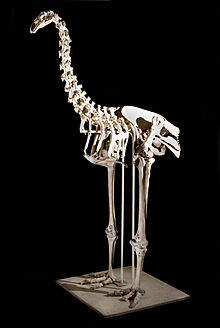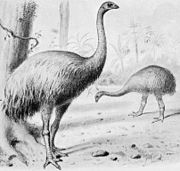South Island giant moa
| South Island giant moa Temporal range: Late Holocene
| |
|---|---|

| |
| Skeleton, likely of an adult male | |
| Scientific classification | |
| Domain: | Eukaryota |
| Kingdom: | Animalia |
| Phylum: | Chordata |
| Class: | Aves |
| Infraclass: | Palaeognathae |
| Order: | †Dinornithiformes |
| Family: | †Dinornithidae |
| Genus: | †Dinornis |
| Species: | †D. robustus
|
| Binomial name | |
| †Dinornis robustus | |
| Synonyms | |
|
List
| |
The South Island giant moa (Dinornis robustus) is an extinct species of moa in the genus Dinornis, known in Māori by the name moa nunui.[2] It was one of the tallest-known bird species to walk the Earth, exceeded in weight only by the heavier but shorter elephant bird of Madagascar (also extinct).[citation needed]
Taxonomy
[edit]The moa were large, flightless birds with a sternum, but without a keel: ratites.[a]
They also had a distinctive jaw and palate. The origin of these birds is becoming clearer, and it is now believed that early ancestors of these birds were able to fly and flew to the southern areas in which they have been found.[3]
Despite being located geographically closer to the kiwi, genetics show moas to have been closest to their sister group, the Central and South American tinamous.
South island giant moas, as well as their close cousins on the North Island, are placed within their own family, Dinornithidae. These, along with the extinct upland moa and tinamous, are among the most basal members of the ratite order.
Description
[edit]Size
[edit]The South Island giant moa was the largest species of moa. Adult females stood up to 2 metres (6 ft 7 in) high at the back, and could reach foliage up to 3.6 metres (11 ft 10 in) off the ground, making them the tallest bird species known.[3][4] Despite their great height, Dinornis robustus was found to have weighed only 200 kilograms (440 lb) on average, with upper estimates of around ≥250 kilograms (550 lb) for females.[4] Only one specimen of complete or partially complete moa egg has been assigned to the South Island giant moa, found around Kaikōura. This egg, 240 millimetres (9.4 in) in length and 178 millimetres (7.0 in) in width, is the largest moa egg found in museum collections as of 2006.[5]
Anatomy
[edit]Very large-bodied, they had proportionately small heads, a trait synonymous with ratites. Analysis of their skull shows that they had somewhat poor eyesight due to their small orbits, rounded bills, and a very acute sense of smell thanks to a strongly developed olfactory system. Dinornis spp. had thinner leg bones than other moa, indicating that they were more agile than other moa, though they likely moved slowly and cautiously. Unusually, giant moas were the only large ratites that sported a hallux (digit 1). Uniquely, the moas were essentially wingless; the only remnant of a wing was the scapulocoracoid bone, which, at one point earlier in its evolution, was where the humerus should have been.

Appearance
[edit]Giant moas were likely fully feathered, except for their heads and a small portion of the neck, as well as the tarsus and feet. There have been feathers found belonging to this species, revealing that its plumage was plain brown or slightly streaked.[4]
Behaviour and ecology
[edit]D. robustus, along with its relatives, were quite eccentric birds. Although they could reach 11+ feet in height, they mostly held their necks horizontally rather than vertically, like their distant relatives, the kiwi.
Feeding
[edit]Moa most likely filled a diurnal role in their ecosystem, similar to that of emus.[6]
Because New Zealand lacked any native terrestrial, herbivorous mammals, the moas filled that niche. Giant moas in particular are ecologically equivalent to giraffes and other long-necked plant-eating megafauna, though they lack any living analogs in New Zealand. These birds sported a very robust bill, and finds of a relatively large collection of gizzard stone for grinding food, indicate a highly fibrous diet.[7] Most foraging took place in forests and open fields. Fossilized coprolites reveal the diet of D. robustus included twigs, seeds, berries, leaves, flowers, vines, herbs, and shrubs. It's likely that this species fed on vegetation that was unable to be digested by other species, therefore avoiding competition with other grazers.[8] Their bill allowed them to feed by means of cutting and breaking twigs and stems via lateral shaking. In addition to their bills, moas had stronger neck muscles than other ratite families, which might have given them a stronger pulling / tugging force.[9] They also could use their necks to reach higher levels, if necessary.
Reproduction
[edit]Giant moas likely were long-lived and took many years to reach full maturation. Similar to cassowaries, females likely were in competition for males, seeing that they were dramatically much larger. Likely similar to all other ratites, the males primarily reared the chicks, as the female would have been too large to incubate the weak-shelled eggs; however, their method of incubation is still unknown. As mentioned before, moas laid very easily breakable eggs. They nested in rock shelters from late spring to early summer. Chicks are speculated to have been striped, like those of other ratites.
Range
[edit]It lived on the South Island of New Zealand as well as in Rakiura[10] and Native Island[11] and its habitat was the lowlands (shrubland, duneland, grassland, and forests).[3] Along with other members of the moa family, the South Island giant moa went extinct due to predation from humans about 200 years after colonisation by Māori.[12]
Footnotes
[edit]- ^ Recent genetic research has incorporated the grouse-like Southern American tinamous clearly into the middle of the ratites; so now there are mid-weight ratites which can fly, even though even the tinamous prefer to remain on the ground.
References
[edit]- ^ Gill, B.J.; Bell, B.D.; Chambers, G.K.; Medway, D.G.; Palma, R.L.; Scofield, R.P.; et al. (2010). Checklist of the Birds of New Zealand, Norfolk and Macquarie Islands, and the Ross Dependency, Antarctica (PDF) (Report) (4th ed.). Ornithological Society of New Zealand / Te Papa Press. Retrieved 30 October 2022 – via nzbirdsonline.org.nz.
- ^ Doyle, Trent (15 November 2023). "Scientists reveal fossilised moa footprints in Otago are at least 3.6 million years old". Newshub. Retrieved 23 February 2024.
- ^ a b c Davies, S.J.J.F. (2003). "Moas". In Hutchins, Michael (ed.). Grzimek's Animal Life Encyclopedia. Vol. 8 Birds I Tinamous and Ratites to Hoatzins (2 ed.). Farmington Hills, MI: Gale Group. pp. 95–98. ISBN 0-7876-5784-0.
- ^ a b c Szabo, M.J. (2022) [2013]. Miskelly, C.M. (ed.). "South Island giant moa". New Zealand Birds Online (updated ed.). Retrieved 28 July 2023.
- ^ Gill, B. J. (2006). "A Catalogue of Moa Eggs (Aves: Dinornithiformes)". Records of the Auckland Museum. 43: 55–80. ISSN 1174-9202. JSTOR 42905885. Wikidata Q58623352.
- ^ Ashwell, Ken; Scofield, R. (2008). "Big birds and their brains: Paleoneurology of the New Zealand moa". Brain, Behavior and Evolution. 71 (2): 151–166. doi:10.1159/000111461. PMID 18032890. S2CID 8334497.
- ^ Tennyson, Alan J. D. (2006). Extinct birds of New Zealand. Paul Martinson. Wellington, N.Z.: Te Papa Press. p. 24. ISBN 978-0-909010-21-8. OCLC 80016906.
- ^ Malory, Marcia (October 2013). "Scientists use fossilized feces to reconstruct moa diet". Phys.org. Retrieved 7 January 2023.
- ^ Attard, M.R.; Wilson, L.A.; Worthy, T.H.; Scofield, P.; Johnston, P.; Parr, W.C.; Wroe, S. (13 January 2016). "Moa diet fits the bill: Virtual reconstruction incorporating mummified remains and prediction of biomechanical performance in avian giants". Proceedings of the Royal Society B: Biological Sciences. 283 (1822): 20152043. doi:10.1098/rspb.2015.2043. PMC 4721086. PMID 26763698.
- ^ Verry, Alexander J.F.; Schmidt, Matthew; Rawlence, Nicolas J. (15 November 2021). "A partial skeleton provides evidence for the former occurrence of moa populations on Rakiura Stewart Island". New Zealand Journal of Ecology. 46 (1).
- ^ Verry, Alexander; Schmidt, Matthew; Rawlence, Nicolas (31 January 2021). "A partial skeleton provides evidence for the former occurrence of moa populations on Rakiura Stewart Island". New Zealand Journal of Ecology. doi:10.20417/nzjecol.46.8. ISSN 0110-6465. S2CID 244026692.
- ^ Perry, George L.W.; Wheeler, Andrew B.; Wood, Jamie R.; Wilmshurst, J.M. (December 2014). "A high-precision chronology for the rapid extinction of New Zealand moa (Aves, Dinornithiformes)". Quaternary Science Reviews. 105: 126–135. Bibcode:2014QSRv..105..126P. doi:10.1016/j.quascirev.2014.09.025.
Other sources
[edit]- Brands, Sheila (14 August 2008). "classification, genus Dinornis". Project: The Taxonomicon (taxonomy.nl). Systema Naturae 2000. Retrieved 4 February 2009.[permanent dead link]
External links
[edit]- Martinson, Paul (artist) (2005). South Island giant moa, Dinornis robustus (watercolor). Extinct birds of New Zealand. Retrieved 24 March 2023 – via Government of New Zealand. from
Tennyson, Alan (2006). Extinct Birds of New Zealand. Wellington, NZ: Te Papa Press.



